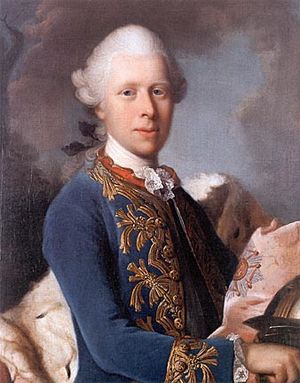Ernest II, Duke of Saxe-Gotha-Altenburg facts for kids
Quick facts for kids Ernest II |
|
|---|---|
 |
|
| Duke of Saxe-Gotha-Altenburg | |
| Reign | 1772–1804 |
| Predecessor | Frederick III |
| Successor | Augustus |
| Born | 30 January 1745 Gotha |
| Died | 20 April 1804 (aged 59) Gotha |
| Spouse | Princess Charlotte of Saxe-Meiningen |
| Issue | Ernest, Hereditary Prince of Saxe-Gotha-Altenburg Augustus Frederick IV Prince Ludwig |
| House | Saxe-Gotha-Altenburg |
| Father | Frederick III, Duke of Saxe-Gotha-Altenburg |
| Mother | Luise Dorothea of Saxe-Meiningen |
Ernest II, Duke of Saxe-Gotha-Altenburg (born in Gotha, January 30, 1745 – died in Gotha, April 20, 1804) was a powerful ruler. He was the Duke of Saxe-Gotha-Altenburg from 1772 until his death in 1804.
Ernest was the second son of Frederick III, Duke of Saxe-Gotha-Altenburg and Luise Dorothea of Saxe-Meiningen. His older brother, Frederick, passed away in 1756. This made Ernest the next in line to rule the duchy of Saxe-Gotha-Altenburg.
Contents
Early Life and Education
Ernest's mother, Luise Dorothea, cared deeply about her sons' education. She made sure Ernest and his younger brother, August, had excellent teachers.
In 1768 and 1769, both princes went on a special trip. They visited the Netherlands, England, and France. During this journey, Ernest met many important people. These included leaders in politics, science, and the arts.
Becoming Duke and His Rule
In 1772, Ernest's father died, and Ernest became the new Duke of Saxe-Gotha-Altenburg. He was a forward-thinking and open-minded ruler. He loved the arts and sciences and worked hard to help them grow.
Ernest improved the education system and the economy in his duchy. He also supported theaters, art collections, and libraries. He was very interested in natural sciences. Because of his efforts, Saxe-Gotha-Altenburg became a leading state among the Saxon duchies in Thuringia.
Focus on Science
Ernest was especially interested in astronomy and physics. He hired talented experts, like the clockmaker Johann Andreas Klindworth. Klindworth was given the title of court mechanic.
For astronomy, Ernest brought the important astronomer Franz Xaver von Zach to Gotha. Together, they built the Observatory of Gotha (Sternwarte Gotha). This observatory became a major center for astronomy in Europe. Ernest wanted this observatory to be a lasting sign of his rule. It was so successful that Gotha became a must-visit place for important people. Even the famous writer Goethe visited several times.
Involvement with Groups
From 1774, Ernest was a Freemason. This was a group that focused on community and shared values. He joined the Gotha Lodge Zum Rautenkranz. This lodge was started by Abel Seyler, Konrad Ekhof, and others from the Seyler Theatre Company.
In 1775, Ernest became the Grand Master of the Landesloge of Germany. Later, in 1783, he joined another group in Bavaria called the Illuminati. He used the names Quintus Severus or Timoleon in this group. In 1784, he became a supervisor for a region called Abessinien (which was a name for Upper Saxony). In 1787, he offered a safe place in Gotha to Adam Weishaupt, who founded this group. Ernest was buried wrapped in a white cloth on a park island.
His Family
On March 21, 1769, Ernest married Princess Charlotte of Saxe-Meiningen in Meiningen. Charlotte was his mother's half-first cousin. They had four sons:
- Ernest (born February 27, 1770 – died December 3, 1779).
- Emil Leopold August, Duke of Saxe-Gotha-Altenburg (born November 23, 1772 – died May 27, 1822). He was known as Augustus.
- Frederick IV, Duke of Saxe-Gotha-Altenburg (born November 28, 1774 – died February 11, 1825).
- Ludwig (born October 21, 1777 – died October 26, 1777).

